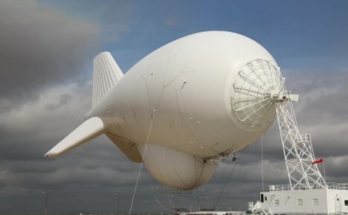by Richard Sterk, Electronic Systems Analyst, Forecast International.
Despite all its setbacks – sequestration, budget cuts, the recent AWOL trip, and a halt to testing – the JLENS program will, technically at least, be funded through completion. However, JLENS will not be produced in the numbers one expected. Initial Operational Capability and low-rate production are expected around 2017. Most likely only the two test models will be produced and put into operational service. Still, IOC will probably be achieved around 2017 as scheduled.
However, with no production contract in sight and only two engineering development models built, this multibillion-dollar development program is realistically dead. Even if the EDMs are pressed into service, paying over a billion dollars per blimp is not the mark of a successful effort.
Developed by Raytheon, the U.S. Army’s Joint Land Attack Cruise Missile Defense Elevated Netted Sensor (JLENS) is a system of two aerostats, or tethered blimps, that float 10,000 feet in the air. The helium-filled aerostats, each nearly as long as a football field, carry powerful radars that can protect a territory roughly the size of Texas from airborne threats. The JLENS provides 360° defensive radar coverage, and can detect and track objects such as cruise missiles, drones, and airplanes from up to 340 miles away.
In October 2015, a JLENS aero-surveillance system blimp went on the offense when it broke from its moorings and created a destructive path of downed powerlines before finally crash-landing miles away. Thanks to the blimp’s joyride, the U.S. Department of Defense suspended the program’s three-year operational trial exercise.
Additionally, the DoD reduced the number of JLENS “orbits” to be produced from 16 to two, triggering a Nunn-McCurdy cost breach. An orbit consists of a fire control radar system and a wide-area surveillance system connected to a ground control station.
In early 2016, the U.S. Army reported that the blimp broke free due to a malfunction of the pressure sensor that caused a loss of air pressure in the tail fins, leading to a loss of aerodynamics. This led to a chain of events that ended with the blimp finally being captured in a pasture like a runaway cow.
For centuries, both the military and civilian sectors have been trying to harness the potential of the airship, usually without much success. Over time, blimps have also proved captivating to the general population. Growing up as a kid, I spent many weekends watching the Goodyear blimps bounce around in the wind in Queens, New York, where they operated out of the since-decommissioned Flushing Airport. It seems, however, that nearly everyone fails to keep in mind that airships, no matter how advanced technologically, will, in the end, always be at the mercy of the weather.
Please feel free to use this content with Forecast International and analyst attributions, along with a link to the article. Contact Ray Peterson at +1 (203) 426-0800 or via email at ray.peterson@forecast1.com for additional analysis.
FI’s eight Electronic Systems Market Intelligence Services cover the full range of defense-related systems and programs in the radar, communications, electro-optical, and electronic warfare markets, presenting a comprehensive market outlook for current equipment as well as new systems being developed as the modern battlefield moves toward a technology-based warfare approach with network-centric capabilities.
For 50 years, Forecast International intelligence reports have been the aerospace and defense industry standard for accurate research, analysis, and projections. Our experienced analysts compile, evaluate, and present accurate data for decision makers. FI's market research reports offer concise analysis of individual programs and identify market opportunities. Each report includes a program overview, detailed statistics, recent developments and a competitive analysis, culminating in production forecasts spanning 10 or 15 years. Let our market intelligence reports be a key part of reducing uncertainties and mastering your specific market and its growth potential. Find out more at www.forecastinternational.com




